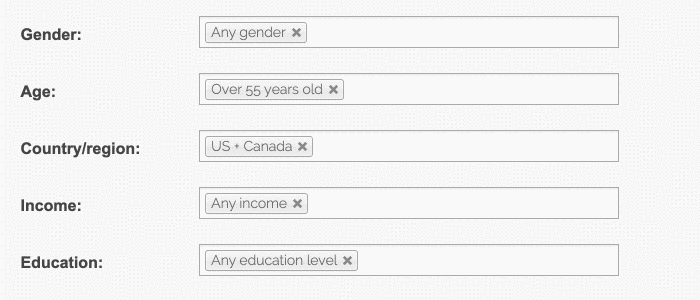One of the most basic features of usability testing with Trymata is access to our pool of 1.5 million testers from around the globe via common demographics.
The basic demographics are:
- Gender
- Age
- Country/region
- Income
- Education
- Employment
- Family status
- Parental status
- Community type
- Social network usage

Most of our customers can expect test fulfillment within 6 hours. The odometer included in the create a new test flow will give your estimate of time completion based on availability of testers in our system.
But what will you do if it’s been over a day since you launched your test, and there are no testers yet? Think about ways to loosen your demographic requirements. Sometimes, it’s faster to put people in the mindset of a targeted demographic than it is to find a reliable amount of that demographic.
We can do this by optimizing our usability test scenario to simulate the context for more generalized demographics.
Register for our FREE trial that includes 5 user testing videos with full features!
Writing a great usability test scenario for niche demographics
Let’s pretend that we are a US-based prescription medicine service that allows automated delivery of medication. We want senior citizens to use our product in this usability test script example.
Here’s a relatively tight demographic filter:

- Gender – Any
- Age – 65-99
- Country/region – US only
- Income – 2nd quartile
- Education – Any
- Employment – Unemployed
- Family status – Any
- Parental status – Any
- Community type – Rural
- Social network usage – Any
It’s sensible to require these demographics:
- Senior citizens in the US are considered 65+
- We’re US-based and only service US customers
- Seniors are typically considered 2nd quartile income levels and unemployed (retired)
- We want to reach rural communities with fewer opportunities for seniors to receive their medicine
However, as we see, the odometer is telling us there’s low chance that this usability test will be completed with these demographics. So why should we consider changing it? Getting your product usability tested at all is ALWAYS better than not testing due to lack of ideal users. Beyond that, putting users in the right frame-of-mind, via the written scenario, can simulate the perfect tester.
Let’s think about how to write something compelling for our usability test scenario, and then adjust our demographics:
“You are a senior citizen in the US with infrequent means of transportation and limited access to pharmacies. However, you depend on daily medication and can become very ill if you don’t maintain a well-regimented schedule of medication. You heard about this service and wanted to see if they can offer you solutions for ensuring you always have medication when you need it.”
What we’re doing is creating a sense of isolation and urgency. We want to paint a picture for testers, one of empathy to better get into the mindset of our niche demographic.
With a great usability test scenario, almost anyone can pretend to be nearly anything, regardless of demographic constraints! So let’s loosen our demographics a little:

- Gender – Any
- Age – 55-75
- Country/region – US + Canada
- Income – Any
- Education – Any
- Employment – Any
- Family status – Any
- Parental status – Any
- Community type – Rural
- Social network usage – Any
For our usability test scenario, we had to keep the Community type, since it is sometimes difficult to convince a stakeholder to give something they believe is important up.
However, we did expand the age to 55, since these are people who may have already dealt with this problem for their own parents, and will need to think about it for themselves down the line.
Our change to US + Canada is extra insurance for getting English-speaking testers with familiarity of healthcare systems similar to the US. Income is rarely, except for e-commerce or higher-end services, a recommended requirement.
Employment was a safety net to help ensure we were getting retirees, but many seniors maintain jobs, and since we expanded our age range, we did not want to squander that change while optimizing our demographics.
*note that Team and Enterprise plans have advanced demographic screening capabilities.
Closing words
Usability testing demographics and scenarios compliment and complete one another, and strong understanding of both will ensure you’re getting the most insightful, actionable, and rapid results possible!
Don’t forget to ensure that you’re testing with the right number of testers! And remember you can purchase additional credits on any plan level if needed!
Thinking about usability testing? Want to see the demographic filtering, screening, and quantitative capabilities of our platform?
Register for our FREE trial that includes 5 user testing videos with full features!





